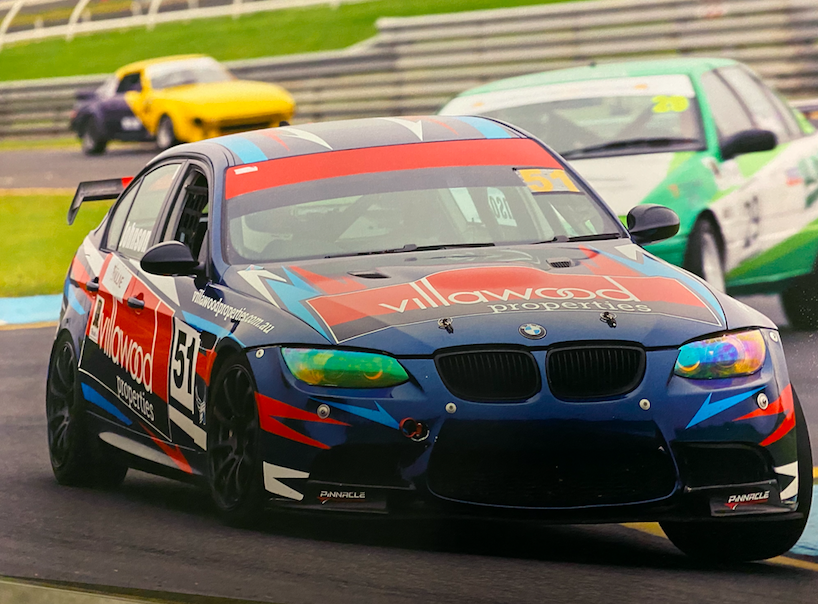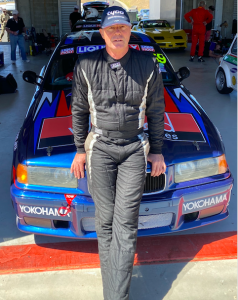
This exec takes his mind off work when he’s doing 260km/h
Villawood Properties executive director Tony Johnson is a self-confessed petrol head, never happier than when he’s going flat-out at Bathurst.
Tony Johnson is executive director of Villawood Properties. He lives in Melbourne.
When did you start racing and why?
Six years ago. I’d wanted to do it since I was young. I was introduced to it by Stephen Gorman, formerly of Bendigo Bank [now chief risk officer at RedZed]. He was at me to do it for years. We had a 25-year relationship with Bendigo Bank; we grew up with them. We’re very close buddies because of that professional and racing friendship.
Type of car, and what did it cost?
I race a fully worked BMW E90. It cost about $100,000.

Why motorsport?
I’m a petrol-head. Many people have the same disease. I race for the excitement and competition. I’ve done a lot of motorcycle riding and trackwork, too. It can be very dangerous. I consider cars slightly less dangerous than doing 260km/h on two wheels, so I’ve switched from bikes to cars.
What class do you compete in, where, and how often?
I compete in Improved Production. The Improved Production Racing Association of Australia runs monthly or bi-monthly fields in states and nationally. I race at Sandown, Winton, Phillip Island, and The Bend in South Australia, and I do Challenge Bathurst every year. The cars are anything from you‑beaut V8 supercars to very hot 1970 Torana GTR XU-1s. There are RX7s and big Ford Falcons as well as Audis and BMWs.
What speeds do you hit?
I can hit up to 260km/h going flat out at somewhere like Conrod Straight on Mount Panorama at Bathurst. It’s full-on circuit racing and there can be up to 35 drivers in a field.
Do you have any restrictions?
There’s a strong set of rules to maintain the integrity of the class. The cars are all souped-up production cars, but you can’t fit a turbo to them if the original didn’t have a turbo. At the early Bathurst races, where they were all production cars, there were certainly lots of specs, but there were brake failures and other problems, so now the cars are basically production with certain modifications.
Preferred race distance?
My preference is for the racetrack rather than the distance. Phillip Island, for instance, is a beautiful, sweeping, safe course. It’s the people’s favourite.
How do other drivers behave?
We have a great camaraderie but once we’re on the track we’ve all got white line fever. We’re highly competitive. We push, then shove; some guys go nuts. There’s a lot of testosterone. Racing is a totally non-team sport.
What motivates you?
What racing is about, whether it’s a bike or a car, is focusing 110 per cent on what you’re doing. If you don’t, it can be very expensive or painful. Racing gives you the opportunity to take your mind off business and other things. It puts you in a different mode; it’s a bit of a brain-cleanser.
Do you train?
I’ve done advanced driver courses and test and tune days, but the real training is seat time. That’s the way to learn the track and the car, and that’s the real secret to training. Physically too – racing can be exhausting, so it requires a certain level of fitness.
Dream race car?
I’m happy with the car I’m running around in, but I do like the really high-tech cars, such as the Porsche GTs. They’re the pinnacle of racing. I also like the souped-up supercars, the big V8 supercars.

Favourite racetrack?
Phillip Island, definitely. It’s a great course. You can pass other drivers and you won’t kill yourself if you run off the track. I used to race bikes there, too. I still ride BMW 1200 GS dirt bikes, but I don’t do track days on bikes any more.
Favourite driver?
Craig Lowndes is a very good driver and, historically, Peter Brock, of course.
If you could drive anywhere, where would it be?
I’ve driven four times in a row at Bathurst. I think driving competitively in a supercar at Bathurst is the Holy Grail. Bathurst is something extraordinary.
Memorable moments?
My most memorable moment was probably driving at Bathurst for the first time. Getting through the full two-day event, it was good just to finish. I hit the wall at Skyline in the wet. It rained all day. I was travelling at well over 140 or 150km/h and braking down a steep hill. The water was like a river and I couldn’t see through the windscreen; it fogged out. I aquaplaned into the wall. I was shaken but I was safe. The car wasn’t that good but fortunately not massively damaged. I’ll never forget it. What’s also memorable is the camaraderie among the drivers. Many of them are small-business people, tradies, normal blokes.
Best advice you’ve ever received?
Start with a simple vehicle. Remember, everyone has white line fever, but you’re only racing for a $25 trophy, so enjoy the moment.
Best way to relax after a race?
These are normally two- or three-day events. I’m pretty hyped up after a race but most probably I’ll wind down over a meal with fellow drivers or going out with friends.
This story was published at lifeandleisure@afr.com 4 July 2022.


